Sentinel
-
- Finding Monsters on the Ocean Surface Marine Technology, Nov 2017 #36
The study of extreme wave events in the ocean has become a popular area of research in recent years. Aside from seafarers, extreme waves impact coastal communities and are of great interest to marine renewable energy companies. This is particularly prevalent in the face of coastal erosion, rising sea levels and uncertainty in how the wave climate will change in a warming world. However, much of the current research is based on modeling and experiments. Extreme wave events – including storm waves, rogue waves, storm surges and tsunamis – are rare, and as such are difficult to observe and measure. Usually the wave categories are divided into two streams: long waves and short waves. Generally, the ratio of depth to wavelength is used as a parameter to differentiate between long and short waves. Tsunamis and storm surges are typically very long waves, so they are considered shallow water waves. Storm waves and rogue waves are much shorter in wavelength relative to ocean depth.
The west coast of Ireland is a perfect location to observe extreme waves, especially when it comes to storm waves and rogue waves. Indeed, Atlantic swells propagate eastward toward the coastline of Ireland. Depressions from the Atlantic regularly bring very unsettled weather across Ireland. A few weeks ago, post-tropical cyclone Ophelia towered waves to the coast of Ireland, with a number of record breaking wave heights.Definition of rogue waves: Oceanographers describe the sea state with a statistical measure called the significant wave height. This is the average height of the one-third highest waves. A rogue wave is one that is more than double the significant wave height. Rogue waves are sometimes called freak waves, but this is misleading: although they are rare and extreme, rogue waves are part of the normal behavior of the oceans.Ocean wave measurement usually uses spectral approaches developed in the 1950s. Surface waves are recorded with a fixed length time series (usually 20 minutes) from which are derived nominal wave spectra. Hardware is based on wave staffs, wire gauges, buoys or underwater acoustic sensors, but device cost means that measurements are made at a single point. These existing techniques have deficiencies: (i) many of the most dangerous wave classes on the ocean either cannot be measured at all or are inaccurately recorded because of sampling deficiencies; (ii) existing wave buoys cannot reliably measure processes such as wave breaking or rogue waves which are all better characterized as instantaneous phenomena and which do not appear in average wave spectra; (iii) sensor cost precludes wide area deployment and inhibits measurement of full spatio-temporal wave evolution dynamics. Buoys only measure accelerations, and a double integration provides displacement. Also, the buoy sensor in the case of a usual Datawell is gimballed in the buoy and can produce spurious large values if the buoy is rotated. Satellite measurements (altimetry) only provide significant wave heights.The Irish winter of 2013-2014 was severely affected by many storms due to the atmospheric jet stream extending right over Ireland carrying successive storms. This exceptional weather combined with high tides resulted in serious coastal damage and widespread flooding. An altimeter pass in the Eastern Atlantic detected phenomenal significant wave heights near 19m just west of Ireland.Prof. Frederic Dias from University College Dublin then decided to organize a measuring campaign for the following winter (2014-2015). He concluded that the best instrument to capture extreme wave events off the west coast of Ireland was an Acoustic Doppler Current Profiler (ADCP). In collaboration with Teledyne RD Instruments (TRDI), a Sentinel V ADCP was deployed in 36m of water at a site off the west coast of Ireland during the winter of 2015 (the experiment was repeated during the winters of 2016 and 2017), with the aim of gathering accurate wave measurements in extreme conditions.The Sentinel V was gimbal-mounted and housed within a trawler-resistant frame and secured to the seabed in an upward-looking configuration. The Sentinel V is one of the latest in a line of ADCP developed by TRDI. It utilizes sonar pulses along five beams to gather measurements of both orbital velocity and echo intensity at predetermined distances (bins) along each beam. The five beams are arranged in the so-called Janus configuration, with beam five in the vertical and beams one-four offset at some predefined angle from the vertical. For this deployment, the Janus angle was 25 (degrees) and 34 bins, each separated by 1.2 m from center to center, were selected along each beam.The nominal vertical distances from the ADCP transducer head to the centers of the first and last bin were approximately 26m and 66m, respectively, giving an effective range of measurement from about 10m below to 30m above the Mean Water Level (MWL). In addition to Doppler readings, pressure was recorded by the Sentinel Vs onboard sensor. The Sentinel V had on board a 16GB memory card. Pitch and Roll readings were recorded by the ADCP’s onboard micro electromechanical systems (MEMS) accelerometers.Velocities and backscatter intensity were recorded along the five beams continuously at 2 Hz for three months. Continuous sampling enabled the capture of details of several giant events with crest-to-trough heights more than 22m. Several theoretical explanations have been proposed for such extreme waves, in particular modulational instability and directional focusing. Typical oceanic wind seas are short-crested, or multidirectional, wave fields and their dynamics is more ‘free’ than the 1D ‘long-wave-guide’ counterpart. Indeed, energy can spread directionally and as a result nonlinear focusing due to modulational instability is diminished. The recorded extreme wave is 22m peak to trough, but does not show any characteristic nonlinear features such as depleted adjacent waves or unusual steepness. Instead it appears more like a standard wave group produced by superposition. What we saw during this extreme event is a group of waves that is moving and grows in amplitude to reach a maximum before it decays.A key quantity to understand the formation of extreme waves is the wave directional spectrum. While traditional statistical approaches have been developed to derive wave directional spectra, the array of five direct surface tracking beams provides an opportunity to construct directional estimates for short time scales or even individual events. A successful investigation into the directional properties of groups of large amplitude waves was performed using time-frequency decomposition methods applied to the surface-track and subsurface velocities measured by the Sentinel V.An independent measure of wave direction was produced through a concept created by Brandon Strong, an engineer at TRDI. This new measure compared well to proven methods.Time frequency decomposition revealed details in wave direction on short time scales necessary to isolate a wave group. Short time scale directional distribution shows that the 22m wave group had a particular direction but that the directional grouping in and around the peak was not different than the rest of the storm. Measurements also showed that the directional variability of this storm was significant making it unlikely that nonlinear models like modulational instability are responsible for this event because they require a quasi-single direction.These figures provide an overview of the entire deployment in 2015, where a significant wave height greater than 10m and maximum wave height greater than 22m was measured, and the extreme wave direction.The AuthorsFrederic Dias received a PhD in Civil and Environmental Engineering from the University of Wisconsin in 1986. He started his career in the U.S. before coming back to France to join CNRS in 1990. In 2000, he moved to Ecole Normale Superieure de Cachan and has been a Professor of Applied Mathematics since.
In 1984 Darryl Symonds started his career at Teledyne RD Instruments (TRDI) located in San Diego. During this career he has worked as an assembler, technician, customer service manager and, starting just over 17 years ago, he became the Director of the Marine Measurements Product Lines (MMPL).(As published in the November/December 2017 edition of Marine Technology Reporter) -
- Offshore Oil & Gas: Brazil’s Northern Frontier Marine Technology, Apr 2014 #34
and covers an area of 11,330 sq. km. The Foz do Amazonas Basin survey is being acquired by the MV Oceanic Endeavour deploying Sercel’s next-generation Sentinel RD solid streamer and started in January 2014. The Sentinel RD has a reduced diameter and a 15% weight reduction, compared to the original Sentinel
-
- Teledyne RD Instruments Updates ADCPs Marine Technology, Oct 2015 #62
Teledyne RD Instruments announced two updates to its Sentinel V ADCP. The enhancements include a complete update to the firmware and the user software interface program, ReadyV, and an update to the post-processing Velocity software package. These two releases provide for added flexibility in the setup of
-
- MN100: Beier Integrated Systems Marine News, Aug 2016 #18
vessel downtime, and achieving the highest level of performance on the open water. Beier Radio, LLC and its subsidiaries (Beier Integrated Systems, Sentinel & The Marine Training Institute), together with its combined 70 employees, are committed to total customer satisfaction by delivering quality products
-
- Melting Sea Ice: A Canary in the Coal Mine Maritime Reporter, Jun 2017 #12
The rapid loss of Arctic sea ice is a sentinel. Most of us will never venture into the Arctic, but it can and does provide us with a forewarning of impacts coming to our parts of the Earth – and some of the most significant impacts will directly affect the maritime industry. In earlier times, coal
-
- Beier Radio Celebrates 70th Anniversary Maritime Reporter, Apr 2015 #105
future needs of our customers in the challenging marine environment,” said owner Karl Beier. “From our expansion into engineering and manufacturing with Sentinel Controls to the opening of the Marine Training Institute, Beier Radio continues to grow and strengthen. We thank our loyal customers around the world
-
- Aluminum Boats Delivers 150-Passenger Excursion Boat To Maryland Tours Maritime Reporter, Mar 1989 #63
Aluminum Boats, Inc. of Crown Point, La., recently delivered the Baltimore Sentinel, a 63- foot-long by 20-foot beam, 150-passenger excursion boat, to Maryland Tours, Inc. of Baltimore, Md. The new vessel made the 2,000-mile delivery trip from its south Louisiana shipyard " ... absolutely trouble-free
-
- Tideland Introduces New Buoy Design For Deepwater Applications Maritime Reporter, Oct 1986 #41
Tideland Signal Corporation of Houston, Texas, has introduced the new SAB-12 Sentinel Articulated Buoy. According to the manufacturer, the buoy has outstanding station- keeping capabilities and may be deployed where water depth makes placement of a fixed structure impractical. The SAB-12 consists
-
- Cummins-Powered Tender Serves Washington State's New Floating Bridge Maritime Reporter, Oct 1989 #37
anchored alongside each other between Seattle and Mercer Island in Lake Washington. Washington State's new bridge tender was designed by Columbia Sentinel Engineers Inc., Seattlebased naval architectural and marine engineering firm, and built by Fishermen's Boat Shop Inc. at Everett, Wash. The 40-ton
-
- Hands Across the Water Marine News, Apr 2015 #36
. was the first U.S. company to produce vessels from Damen designs on a large scale. In January, Bollinger delivered to the U.S. Coast Guard its twelfth, Sentinel-class Fast Response Cutter, based on Damen’s Stan Patrol Boat 4708 design. The vessel has a flank speed of 28 knots; the latest command, control
-
- Energy Markets Buoy U.S. Shipbuilding Maritime Reporter, Aug 2014 #90
lift rudders for a combination of performance and fuel economy. Bollinger Shipyards, Inc., Lockport, La., recently won a contract for six additional USCG Sentinel Class Fast Response Cutters (FRCs). The U.S. Coast Guard (USCG) awarded a $255 million contract option to Bollinger Shipyards of Lockport, La., July
-
- Budget Battles Bumping Backlogs? Marine News, May 2013 #28
in a number of nations. Bollinger Shipyards: in the thick of the battle Bollinger Shipyards has so far weathered federal budget cuts, delivering five Sentinel Class Fast Response Cutters under a sizable contract with the U.S. Coast Guard. ”As of today, our contract is for 18 units, with a potential for 34
-
 )
March 2024 - Marine Technology Reporter page: 15
)
March 2024 - Marine Technology Reporter page: 15options for longer mission periods. About the Author For glider users working in ? sheries and conservation, Shea Quinn is the Product Line Manager the Sentinel can run several high-energy passive and active of the Slocum Glider at Teledyne Webb acoustic sensors, on-board processing, and imaging hardware
-
 )
March 2024 - Marine Technology Reporter page: 14
)
March 2024 - Marine Technology Reporter page: 14up to on track in strong currents or other dif? cult ocean condi- 8 different sensor or hardware integrations. tions,” said Quinn. “The size of the Sentinel gives it the energy capacity to in- The Slocum Sentinel Glider uses the established piloting, crease mission length to over 2 years; or users can
-
 )
March 2024 - Marine Technology Reporter page: 13
)
March 2024 - Marine Technology Reporter page: 13(AUVs) is certainly “As the use of Slocum Gliders grew, Manager at TWR. A familiar with the popular- so did demand for increased capabil- The Slocum Sentinel Glider scales ity this type of platform has seen over ity: longer missions, more sensors – the standard Slocum Glider through an the past two
-
 )
March 2024 - Marine Technology Reporter page: 12
)
March 2024 - Marine Technology Reporter page: 12TECH FEATURE TELEDYNE SLOCUM GLIDERS Teledyne Webb Research Engineers deploy the Slocum Sentinel Glider in Cape Cod Bay for testing. Teledyne Webb Research AS THE GLIDER COMMUNITY GROWS, SO DO GLIDERS By Shea Quinn, Slocum Glider Product Line Manager, Teledyne Marine 12 March/April 2024 MTR #3 (1-17).
-
 )
March 2024 - Marine Technology Reporter page: 2
)
March 2024 - Marine Technology Reporter page: 2Black Sea Mines When the shooting stops in the Ukraine, the tough work of clearing mines will commence. By David Strachan 12 Gliders Slocum Sentinel 22 Teledyne Marine debuts the Slocum Sentinel Glider. By Shea Quinn 22 Instrumentation Volcano Hunter 28 Detecting the unknown in the wake
-
 )
August 2023 - Maritime Reporter and Engineering News page: 53
)
August 2023 - Maritime Reporter and Engineering News page: 53USNS Wat- kins repairs were carried out. Bayonne Drydock is currently scheduled to be- gin its next project with the USCG in August, hauling the 154-ft. Sentinel Class Cutter Angela Mcshan. -426-7818SERVICE•INTEGRITY 800-426-7818 SERVICE • INTEGRITY • RELIABILITY HOUGEN.COM www.marinelink.com 53 MR
-
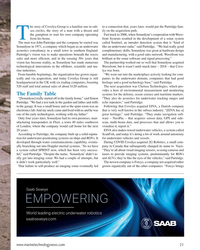 )
May 2023 - Marine Technology Reporter page: 21
)
May 2023 - Marine Technology Reporter page: 21with Wave- T from his home. front Systems resulted in the development of a sonar system The man was John Partridge and the company he started was called Sentinel, an intruder detection system that is “kind of Sonardyne in 1971, a company which began as an underwater like an underwater radar,” said Partridge
-
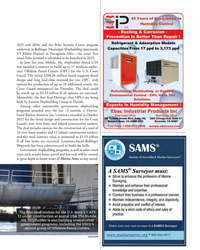 )
April 2023 - Marine News page: 35
)
April 2023 - Marine News page: 35Cutter program underway at Bollinger Mississippi Shipbuilding (previously VT Halter Marine) in Pascagoula, Miss.—the series’ ? rst vessel Polar Sentinel is scheduled to be launched in 2025. In June last year, Mobile, Ala. shipbuilder Austal USA was awarded a contract to build up to 11 medium-endur- ance
-
 )
June 2022 - Maritime Reporter and Engineering News page: 45
)
June 2022 - Maritime Reporter and Engineering News page: 45for Sector Honolulu Cmdr. Aja Kirksey said the option of sending an FRC with a WLB to- gether as a surface action unit (SAG) has proven to be success- Sentinel Class Fast ful. But these long deployments have risk, and we shouldn’t assume that because we’ve done it that we should continue to Response Cutters do
-
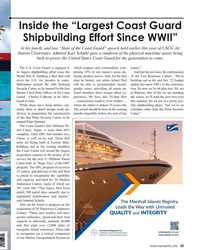 )
April 2022 - Maritime Reporter and Engineering News page: 35
)
April 2022 - Maritime Reporter and Engineering News page: 35Security derway in preparation for construction months hopefully before the end of my Cutter.” of the ? rst Polar Security Cutter, to be named Polar Sentinel. The Coast Guard’s ? rst Offshore Pa- trol Cutter, Argus, is more than 60% complete, while OPC hull number two, Chase, is well on its way. These
-
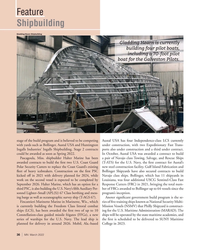 )
March 2022 - Marine News page: 36
)
March 2022 - Marine News page: 36Navajo class ships. Bollinger, which has 11 shipyards in work on the second vessel is expected to be completed by Louisiana, was four additional USCG Sentinel-Class Fast September 2026. Halter Marine, which has an option for a Response Cutters (FRC) in 2021, bringing the total num- third PSC, is also building
-
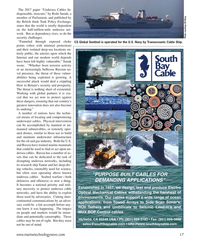 )
March 2022 - Marine Technology Reporter page: 17
)
March 2022 - Marine Technology Reporter page: 17undersea net- work. But as dependency rises, so do the Photo courtesy US Navy security challenges. “Funneled through exposed choke CS Global Sentinel is operated for the U.S. Navy by Transoceanic Cable Ship. points (often with minimal protection) and their isolated deep-sea locations en- tirely
-
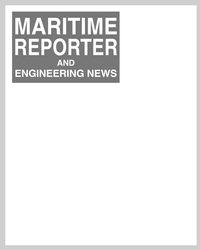 )
March 2022 - Maritime Reporter and Engineering News page: 17
)
March 2022 - Maritime Reporter and Engineering News page: 17undersea net- work. But as dependency rises, so do the Photo courtesy US Navy security challenges. “Funneled through exposed choke CS Global Sentinel is operated for the U.S. Navy by Transoceanic Cable Ship. points (often with minimal protection) and their isolated deep-sea locations en- tirely
-
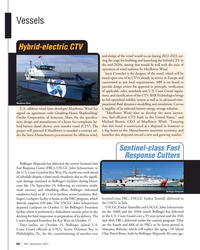 )
November 2021 - Marine News page: 68
)
November 2021 - Marine News page: 68Massachusetts maritime economy and der the latest Massachusetts procurement for offshore wind, launches this shipyard toward a new and growing market.” Sentinel-class Fast Response Cutters Bollinger Shipyards has delivered the newest Sentinel-class Fast Response Cutter (FRC), USCGC John Scheuerman, to the
-
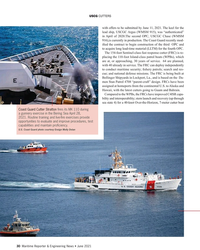 )
June 2021 - Maritime Reporter and Engineering News page: 30
)
June 2021 - Maritime Reporter and Engineering News page: 30recently mod- i? ed the contract to begin construction of the third OPC and to acquire long lead-time material (LLTM) for the fourth OPC. The 154-foot Sentinel-class fast response cutter (FRC) is re- placing the 110-foot Island-class patrol boats (WPBs), which are at, or approaching, 30 years of service
-
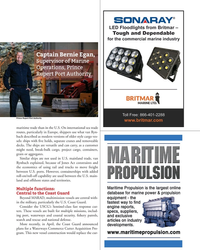 )
June 2021 - Marine News page: 35
)
June 2021 - Marine News page: 35Central to the Coast Guard Beyond MARAD, multimission vessels are central with- in the military, particularly the U.S. Coast Guard. Consider the USCG’s Sentinel-class fast response cut- ters. These vessels are built for multiple missions, includ- ing port, waterways and coastal security, ? shery patrols,
-
 )
March 2021 - Marine Technology Reporter page: 52
)
March 2021 - Marine Technology Reporter page: 52with a more powerful and ef? cient data lution 3D imaging of targeted offshore engine with improved positioning accu- areas. racy. Using Sercel’s Sentinel streamer tech- SiNAPS 2 supports USBL, LBL, and Teledyne CARIS nology and Kappa Offshore Solutions’ advanced hybrid positioning methods, Announces
-
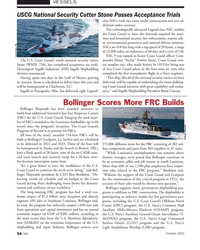 )
October 2020 - Marine News page: 54
)
October 2020 - Marine News page: 54Ingalls Shipbuilding President Brian Cuccias. Bollinger Scores More FRC Builds Bollinger Shipyards has been awarded contracts to build four additional Sentinel-Class Fast Response Cutters (FRC) for the U.S. Coast Guard, bringing the total num- ber of FRCs awarded to the Louisiana shipbuilder up to 60 vessels
-
 )
July 2020 - Marine Technology Reporter page: 16
)
July 2020 - Marine Technology Reporter page: 16. working to detect aggregated patches of to check each highlighted pixel for simi- Realizing that one of the many knowl- plastics using the ESA’s Sentinel-2 sat- larity to the spectral shape of plastic,” edge gaps in microplastic research is ellites and corresponding data archive. Biermann added.
-
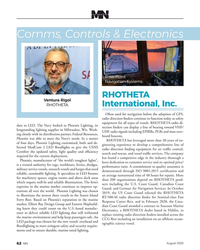 )
August 2020 - Marine News page: 62
)
August 2020 - Marine News page: 62chosen 2019, the US Coast Guard selected the RHOTHETA to illuminate the newest three vessels in the Staten Island RT-500-M radio direction ? nder for Sentinel-class Fast Ferry ? eet. Based on Phoenix’s reputation in the marine Response Cutter ? eet, and in February 2020, the Cana- market, Elliott Bay
-
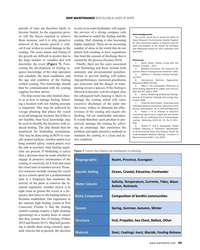 )
May 2020 - Maritime Reporter and Engineering News page: 49
)
May 2020 - Maritime Reporter and Engineering News page: 49an ROV to visu- maintain the coating in a clean and ac- Marine Science 6:467, June 2019 ally inspect surfaces. Another option is to tive condition. hang sentinel epoxy coated panels over the side to ascertain what fouling organ- Figure 7. Factors that influence the development of biofouling. isms are present
-
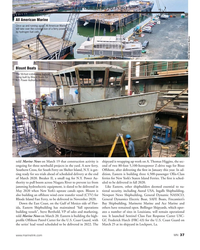 )
April 2020 - Marine News page: 37
)
April 2020 - Marine News page: 37and marketing, ates a number of sites in Louisiana, will remain operational told Marine News on March 20. Eastern is building the high- too. It launched Sentinel Class Fast Response Cutter USC- pro?le Offshore Patrol Cutter for the U.S. Coast Guard, with GC Frederick Hatch (FRC-43) for the U.S. Coast Guard
-
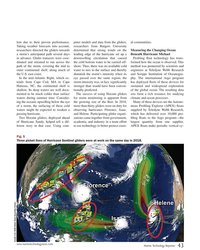 )
January 2020 - Marine Technology Reporter page: 43
)
January 2020 - Marine Technology Reporter page: 43story in that case. Using com- to use technology to better protect coast- APEX ? oats make periodic vertical cy- Fig. 5 Three picket lines of Hurricane Sentinel gliders were at work on the same day in 2018. Credit: U.S. IOOS Glider Data Assembly Center www.marinetechnologynews.com Marine Technology Reporter
-
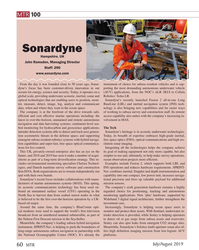 )
July 2019 - Marine Technology Reporter page: 60
)
July 2019 - Marine Technology Reporter page: 60, Sonardyne is helping ocean space users to cal modems were used to support the world’s ? rst television monitor and protect their assets. With Sentinel, underwater in- broadcast from an untethered manned submersible, as part of truder detection is provided, while Sentry is helping operators the
